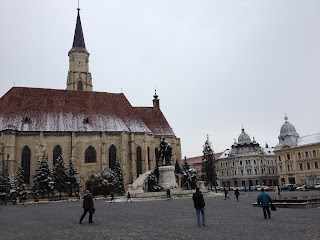
The Unitarian Archives have been raided by the many invaders of the last centuries. Probably the most damaging were the Communists who simply claimed ownership of everything and removed
many ancient manuscripts to their state libraries. Currently Molnar Lehel, Archivist, is looking for a 1566
Cathechism where Fenencz David, George Biandrata and others recast the Heidleberg Cathecism
in an early Unitarian light. It was removed from the Unitarian Library in 1948 and was in the Romanian Library. It was not there several weeks ago when he looked. He has learned of fragments in a library in Hungary. The search goes on.
Meanwhile, Lehel is holding the 18th century Unitario-Ecclestiastica Historia Transylvania.
This religious history is in Latin
and is the life work of two men in succession, John Kenosi-Tozser and Steven Uzoni Foszto.
Remember this oddly-shaped wooden case? Lehel found it in a dusty storage room and inside was a cello,
badly damaged. It turned out it belonged to a Unitarian renaissance man- scholar, educator, musician for whom the high school is named- Brassai Samuel. The cello has been restored and a master cellist has been chosen to play it for three years, then it will go on to another with the provision that the cellist
play for special High School events.
Work table for a volunteer who is archiving local Unitarian church records.
Back to my work place- note front of cello case. Lately I have been intrigued by a letter by
James Martineau, preeminent British Unitarian minister, theologian,
author and principal of Manchester New College.
He wrote a stunningly beautiful letter to Bishop Ferencz Joseph in Kolozsvar in 1879 on the 300th anniversary of the death of Ferencz David,
"We do not address you as strangers. More than half a century ago, when our (British Unitarian) Association was formed, one of its first duties was to open communication with your churches..."
Here is a close up of the big Transylvanian church history.
Parts of it have been edited and published recently.
1587-1606
Partiale Generalae Consistorium
The earliest recorded of the governing body of the church- a representative
group of clergy, lay people and staff.
The modern-day Consistorium met here last week.
Pakei Lajos was a preeminent Unitarian architect from Kolozsvar
who designed many major buildings here around 1900. He designed the headquarters/high school/seminary/ Bishop's office where I am staying in the attic!
This poster announces a special exhibition of his work and a scholarly
presentation based on a newly-published book of his work, author below (note Pakei photo to right)
Students studying Pakei's architectural drawing loaned from among 600 drawings in Unitarian Archives.
They were finding their rooms and the many stairways they travel.
Lehel as expert archivist at reception.
A nice entertainment at the Pakei reception and presentation.
Pakei's work- the Headquarter's building. He also designed the Unitarian High school in Szekelyudvarhely
where our Shoreline UU Pilgrimage is taking English books in mid April 2013. The drawing look very similar to the Kolozsvar school, but smaller. Lehel is from the town with the smaller school and attended it. His father and grandfather ran the local museum in town.
Au revoir! I'm taking off for the Easter Break and will share
how Transylvania Unitarians celebrate Easter
in about ten days.
We may have more in common than you might imagine!
Rev. Claudia




















































